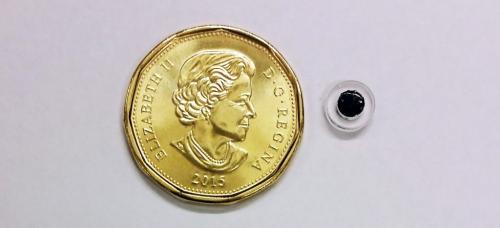New Magnetic Implant Offers Controlled Drug Delivery
February 21, 2017
Canadian researchers have created a new implantable device that can be triggered to release drugs by passing a magnet over the device outside the skin.
Kristopher Sturgis

Shown is an image of the magnetic implant next to the Canadian
one-dollar coin.
A new implantable drug delivery device was revealed last week by researchers from the University of British Columbia that could be used as an alternative for patients who rely on a high number of pills or intravenous injections for treatment. The new device was designed to be magnetically activated and controlled upon surgical implantation.
The device measures just six millimeters in diameter and consists of a silicone sponge with magnetic carbonyl iron particles that are wrapped in a polymer layer. The sponge can be injected with drugs before being surgically implanted into an area of the body that is being treated. Once the device is placed at the desired site, it can then be triggered by passing a magnet over the patient's skin to release the drugs into the surrounding tissue. Study author Ali Shademani told university news that the rate of release can even be controlled by using different magnet strengths.
"Drug implants can be safe and effective for treating many conditions, and magnetically controlled implants are particularly interesting because you can adjust the dose after implantation by using different magnet strengths," he said. "Many other implants lack that feature."
New drug delivery methods continue to crop up as researchers search for new ways to control the release of drugs into specific areas of the body. Last month engineers from UC San Diego designed microscopic submarine-like drug delivery devices that can independently navigate the harsh conditions of the stomach and release drugs to treat stomach ulcers and bacterial infections. The tiny device was developed to help treat conditions of the stomach, a tough place for drugs to reach without being broken down by gastric acid. The drug delivery vehicle could eventually be used to treat virtually any stomach disease that responds to acid-sensitive drugs.
Similarly, this new magnetic implant could evolve to become a drug delivery device that can administer a variety of different drugs from painkillers and hormones, to actual chemotherapy drugs -- and the ability to control the dosage could be particularly useful for conditions where the required dose varies from patient to patient, like diabetes.
The group initially tested the device on animal tissue in a lab setting using the prostate cancer drug known as docetaxel. Initial studies have shown that after repeated use, the device was able to deliver the drugs on demand, while producing a desired effect on cancer cells comparable to those achieved by freshly administering the drug through traditional means.
The group aims to continue to refine the device as they move forward with their research in the hopes of narrowing down the conditions for its use, and expanding its abilities and overall impact. The next step is to test the device for long-term use, as well as its viability in living models. They also aim to ensure that drugs stored in the device can maintain their composition, so as to maximize the device's effectiveness and ability to endure different environments inside the body. Researchers aim to have the device prepared for clinical use within the next few years.
Kristopher Sturgis is a contributor to Qmed.
About the Author(s)
You May Also Like


